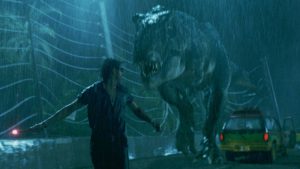If you remember the entire Jurassic Park movie, you know the larger plot tells a major, paradigmatic story about nature that wasn’t visible in the scene where the scientists and movie-goers first met the dinosaurs. This larger story expresses Western culture’s paradigm of nature as ruthless, and as so dangerous to human beings that they must keep it under control. So, if you’ve seen the movie, using Jurassic Park to illustrate a paradigm shift inadvertently introduced this other paradigm to your subconscious awareness too — and planted the idea that paradigm shifts have disastrous outcomes. So we need to unpack that and deal with it.

Several of the movie’s more terrifying scenes play out in a dark forest, at night, during a violent storm that seems to go on forever. This combination is such a common trope of “man against nature” in Western culture (and yes, the trope is “man” rather than “people”) that it was parodied in in the 1975 film Monty Python and the Holy Grail. A dark forest, night, and miserable wet weather are common elements of the Dark Forest Myth (Adams and Belasco 2015) that expresses Western culture’s primary paradigm about the relationship between human beings and the natural world: that Nature is dangerous, and humans must master and control it in order to survive (Adams and Belasco 2015:2). In Monty Python and the Holy Grail, the knight survives because people have built a castle in the forest. Building a structure is one way people master the natural environment. In Jurassic Park the people survive by being helicoptered from the island — another victory of human technology over the natural world.
In a scene from Monty Python and the Holy Grail, a knight struggles through a dark and stormy night in the forest as wild animals howl in a threatening way. This parody works because the Dark Forest Myth is so common in Western culture as to be a trope. Credits: Monty Python and the Holy Grail. 1975. Michael White Productions, National Film Trustee Company, and Python (Monty) Productions. Terry Gilliam and Terry Jones, Directors. Graham Chapman, John Cleese, Eric Idle, Terry Gilliam, Terry Jones, and Michael Palin, Writers. Used under Fair Use as stated in the Copyright Act of 1976, 17 U.S.C. § 107.
Of course, the Dark Forest mythic paradigm means that as environmental conditions get worse, people of Western culture feel more and more determined to roll up their sleeves and “fix” it.
You might wonder why, if the movie Jurassic Park tells such a dark story about the human-nature relationship, the opening scene where we and the awe-struck paleontologists first see the dinosaurs feels so uplifting. That scene is a classic expression of the first scene in any telling of the Dark Forest Myth: “the fleeting moment of wonder” (Adams and Belasco, 2015:16). The “fleeting moment of wonder” is the initial encounter of the story’s heroes (and through them, ourselves) with whatever part of the natural world the story is going to engage us all with. That initial encounter is one in which the beauty, sheer size, or power of a shark, tornado, dinosaur, or vast landscape elicits a deep sense of awe or wonder in the Hero and in us. The momentary wonder is “fleeting” because this particular mythic story casts the natural world in the role of dangerous enemy. So the moment of wonder can’t last. Nature always shows its [supposedly] true colors after that, and the fight is on. Of course that’s exactly what happens in Jurassic Park.
So if you saw Jurassic Park, or even if you simply know the story goes that direction (it’s not hard to predict!), don’t let your appreciation of the dinosaur paradigm shift we looked at get tainted with the deep suspicion that the Indigenous view of the natural world you hope will be a wonderous and healing new paradigm is, instead — like the dinosaurs in the movie — ready to destroy you if you let down your guard. Because, of course, if you think that — even subconciously — you will not let down your guard. And that will make it impossible for you to make this paradigm shift. Perhaps you can see here why it’s so important to recognize the paradigmatic things our culture’s stories tell us. If we can’t see them, we can’t reason our way out of a paradigm that doesn’t work any more but that’s still embedded in the stories that grab our emotions.
Click here to return to the list of pages at Weaving the Basket.
Click here for list of References.
